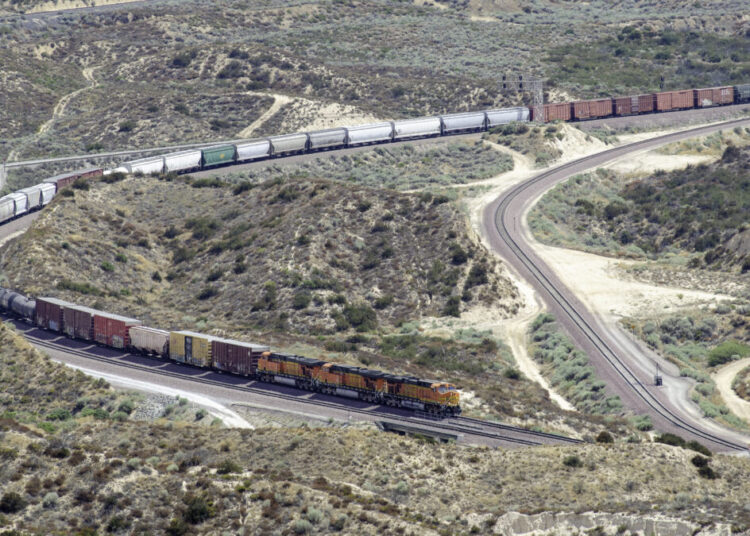Two popular issues among rail unions — train lengths and train crew sizes — have gained traction in state legislatures, with a bill in the Nevada legislature limiting train lengths and a provision requiring train crew sizes of at least two people becoming law in Ohio.
In Nevada, Assembly Bill No. 456 seeks to prohibit trains more than 7,500 feet long on main lines, which would consist of railroad tracks that see 5 million gross tons or more transported annually, as well as on lines that branch off from the main line.
Violating the proposed rule would result in growing fines: up to $5,000 for the first violation, then up to $10,000 for the second violation and $25,000 for the third violation or any subsequent violations within three years after the first violation.
The bill would directly affect the two Class I railroads operating in Nevada: Union Pacific (NYSE: UNP) and BNSF (NYSE: BRK.B).
According to the Association of American Railroads (AAR), 75% of trains operated by the Class I railroads were shorter than 8,000 feet in 2021 and 2022, with the average size being 5,400 feet in 2021. AAR says that technical advances, such as placing locomotives in the middle of the train instead of just the front, have allowed the railroads to increase train length safely, while longer trains also enable improved fuel efficiency and hasten the reduction of greenhouse gas emissions.
But the unions have said that longer trains require more time for a train crew member to reach an area of the train where there might be an issue because the distance to and from the locomotive cab is longer. Union members have also questioned whether longer trains affect the physical forces on the train and make it more susceptible to derailments. Meanwhile, some politicians have said longer trains can tie up local traffic because they can block railroad crossings.
2-person crews become law in Ohio
Meanwhile, in Ohio, Gov. Mike DeWine recently signed a bill that includes requiring freight train crews of at least two people. That provision was part of a wider $13.5 billion transportation budget bill signed into law last Friday.
The unions have been arguing that a locomotive engineer and train conductor serve complementary functions, with a conductor being able to respond to unplanned situations and incidents in ways that an engineer cannot.
The railroads have said positive train control can help in performing a conductor’s functions, enabling the conductor to work in a ground-based position instead of inside the locomotive cab. However, both UP and Norfolk Southern (NYSE: NSC) have said they are suspending for now their programs to pursue one-person train crews.
The Federal Railroad Administration has also proposed under the Biden administration requiring a train crew size of at least two people.
The passage of the train crew size provision comes as the Feb. 3 train derailment of an NS train in East Palestine, Ohio, garnered national attention. Subsequent incidents involving NS trains have also occurred, including a fatality at a customer facility served by NS.
“These changes in state law will ensure that railroads operating in Ohio are following the best practices in monitoring railroad equipment and will assist the state with holding railroads responsible for their actions,” said a Friday announcement on the passage of the transportation budget bill.
“Technology cannot replace the eyes and ears of two certified train crew members. As we saw in East Palestine, there’s no way ground-based employees could respond to derailments faster than employees already inside the locomotive cab,” BLET President Eddie Hall said in a Thursday release. “I am pleased that Governor DeWine and his fellow Ohio lawmakers could see through the usual rhetoric spouted by rail corporate lobbyists.”
Besides addressing train crew size, the bill requires wayside defect detectors to be installed every 10 to 15 miles along main line track in Ohio and charges the Public Utilities Commission of Ohio to ensure compliance, according to BLET.
Said BLET Ohio State Legislative Board Chairman John Esterly: “Ohio is now the first and only state with requirements for wayside detectors. We need to see this spread like wildfire, ideally to U.S. Congress.”
The bill takes effect on July 1.
Subscribe to FreightWaves’ e-newsletters and get the latest insights on freight right in your inbox.
Click here for more FreightWaves articles by Joanna Marsh.
Related links:
Iowa bill seeks to limit length of freight trains
Union Pacific, SMART-TD agree to suspend train crew reconfiguration
NS, SMART-TD to hold off on conductor redeployment talks
FRA hears clashing views from railroads, unions on train crew size
The post Train length and train crew sizes see state legislative action appeared first on FreightWaves.














